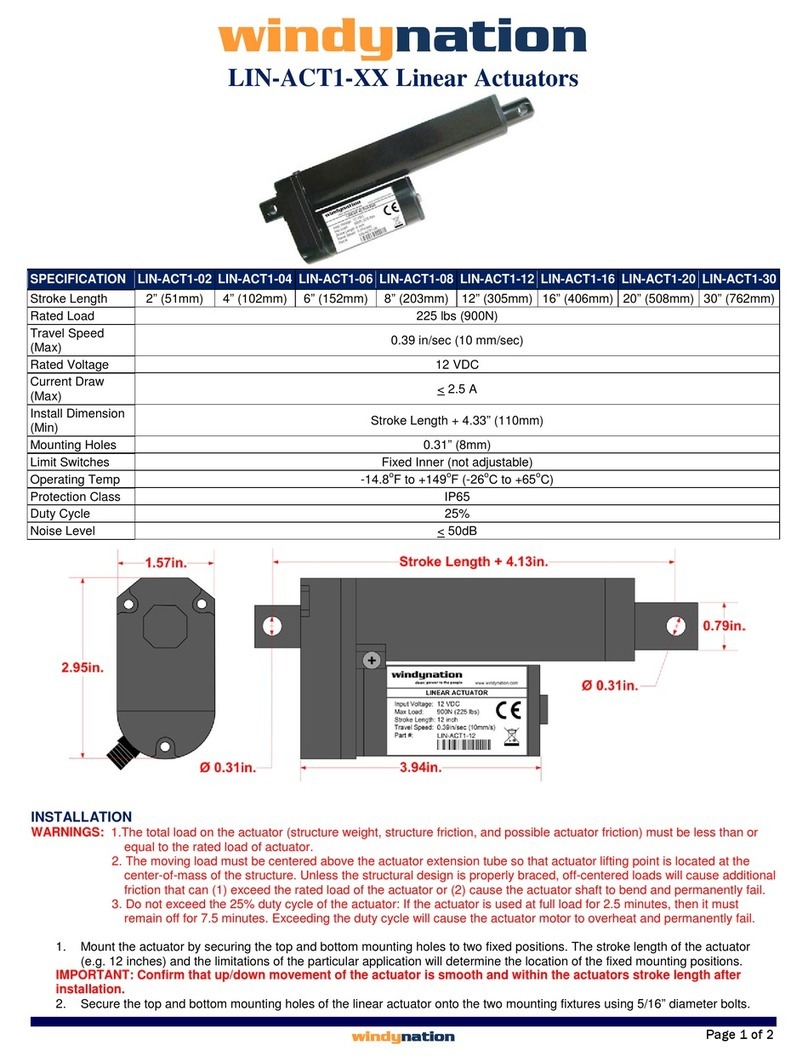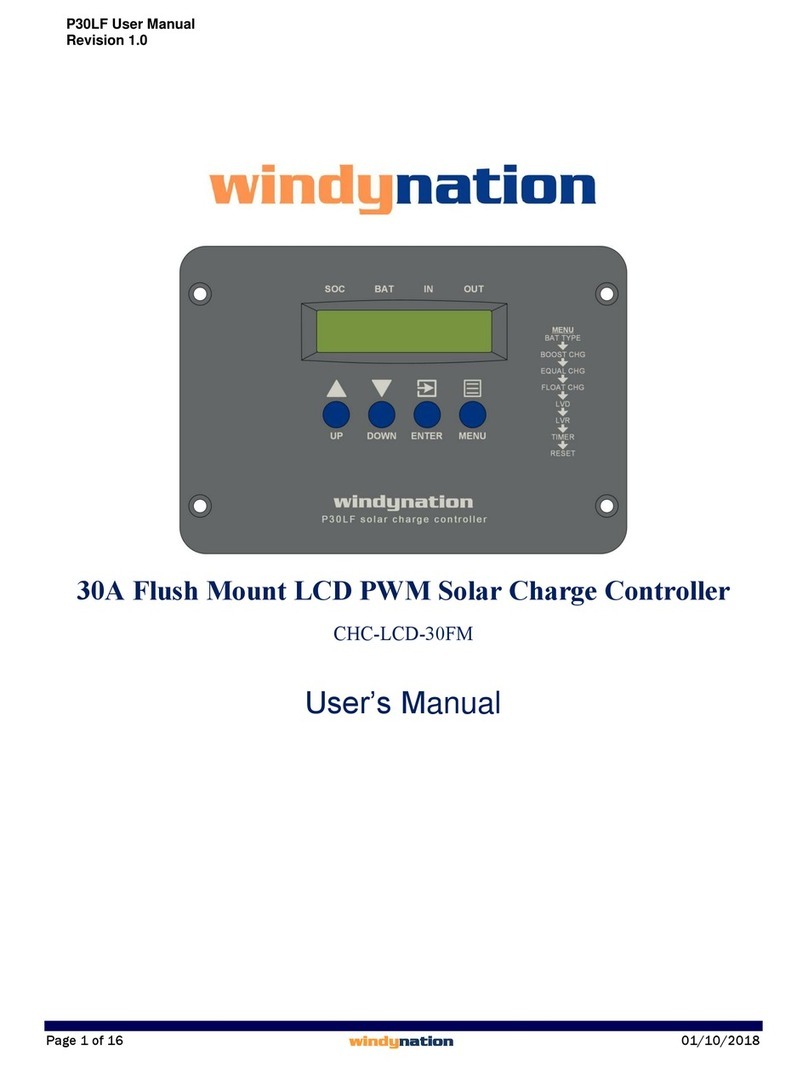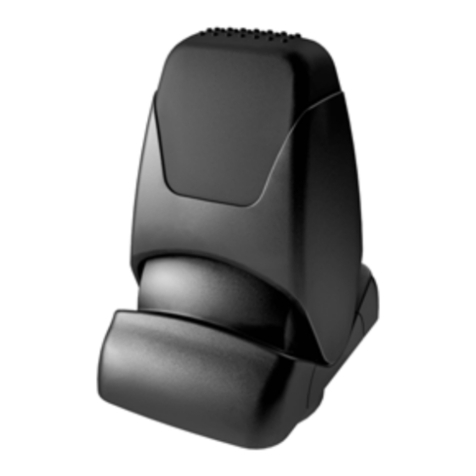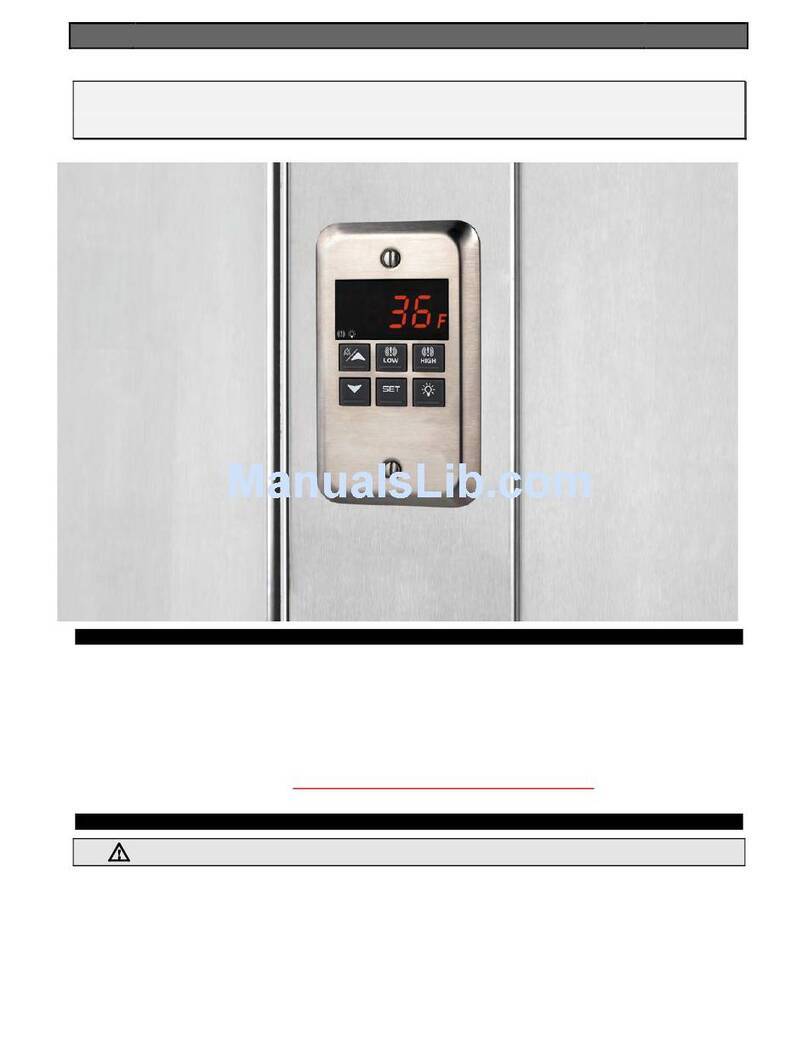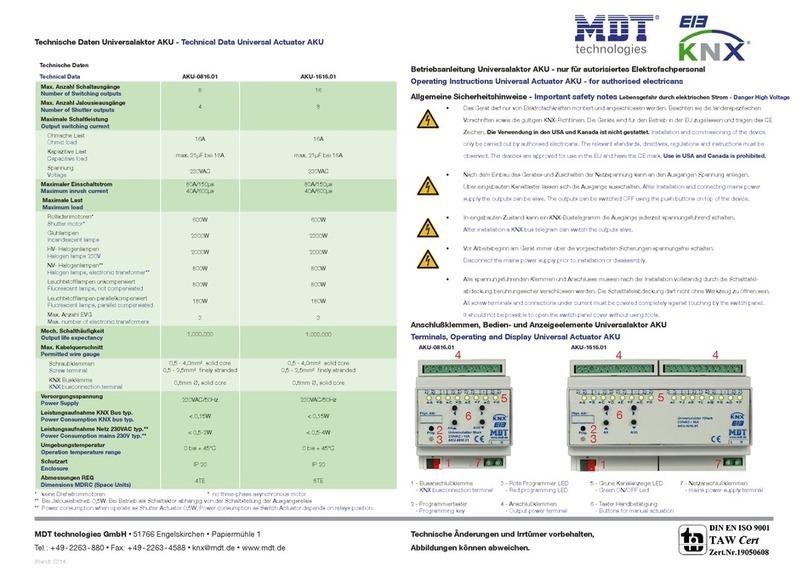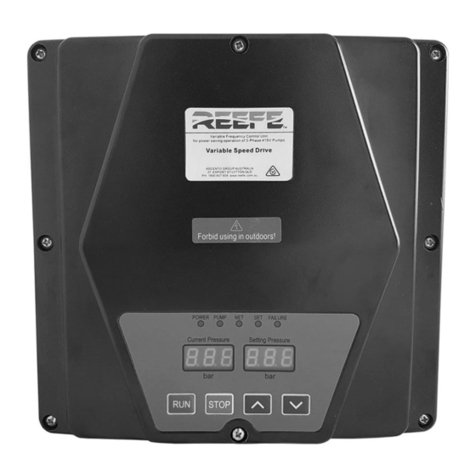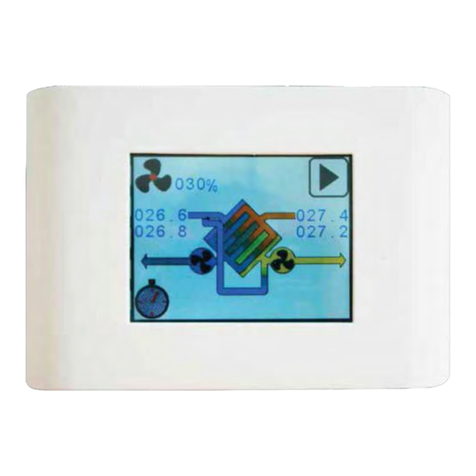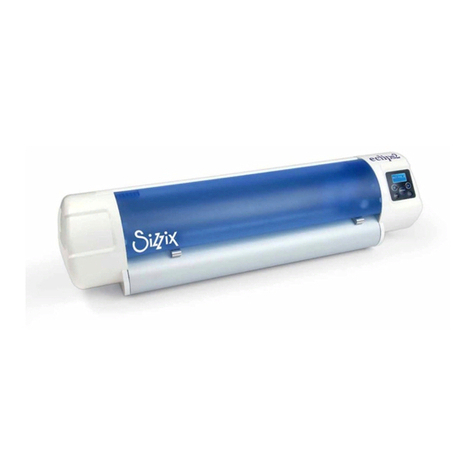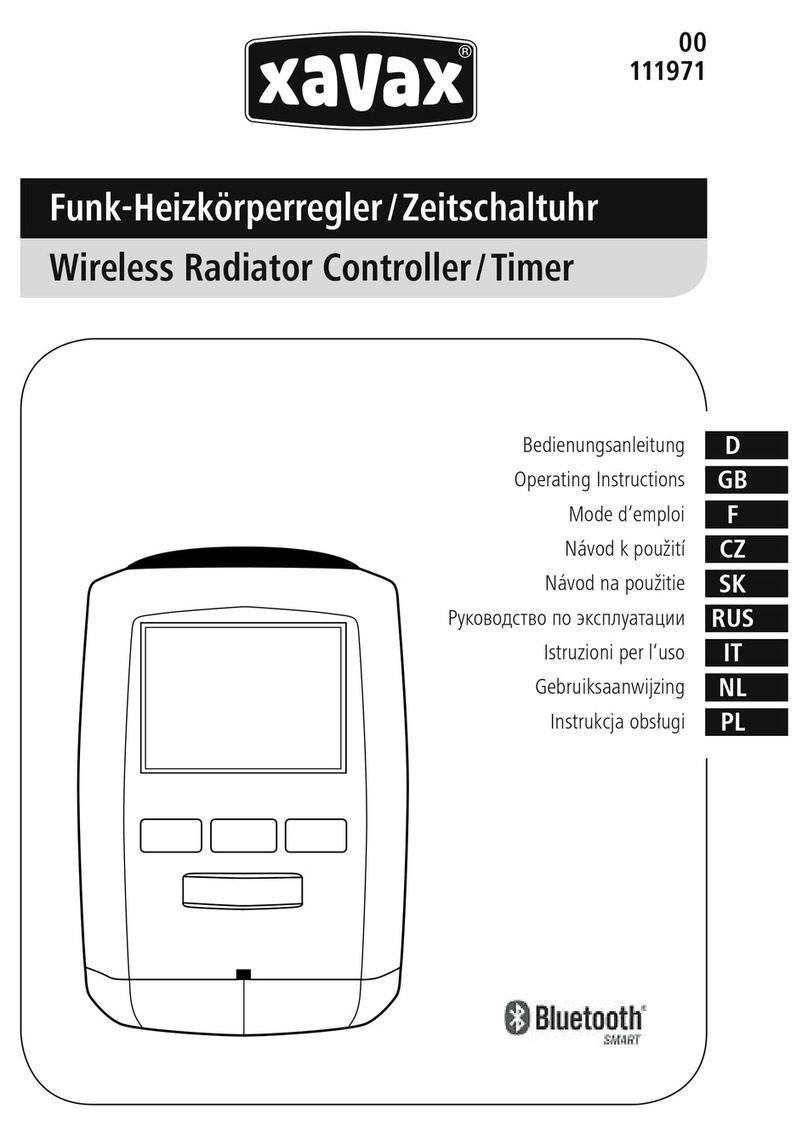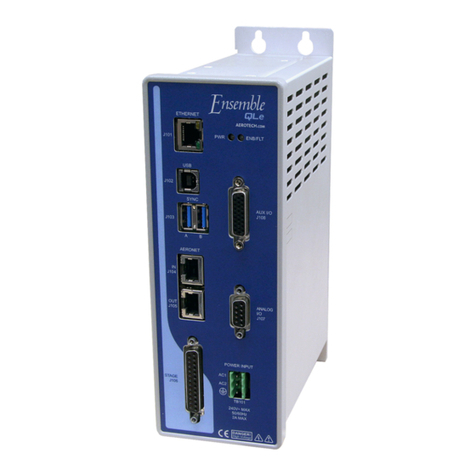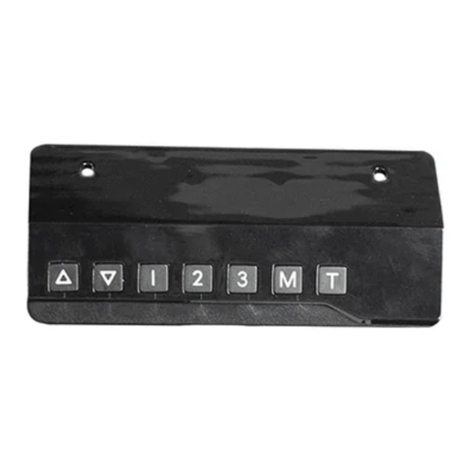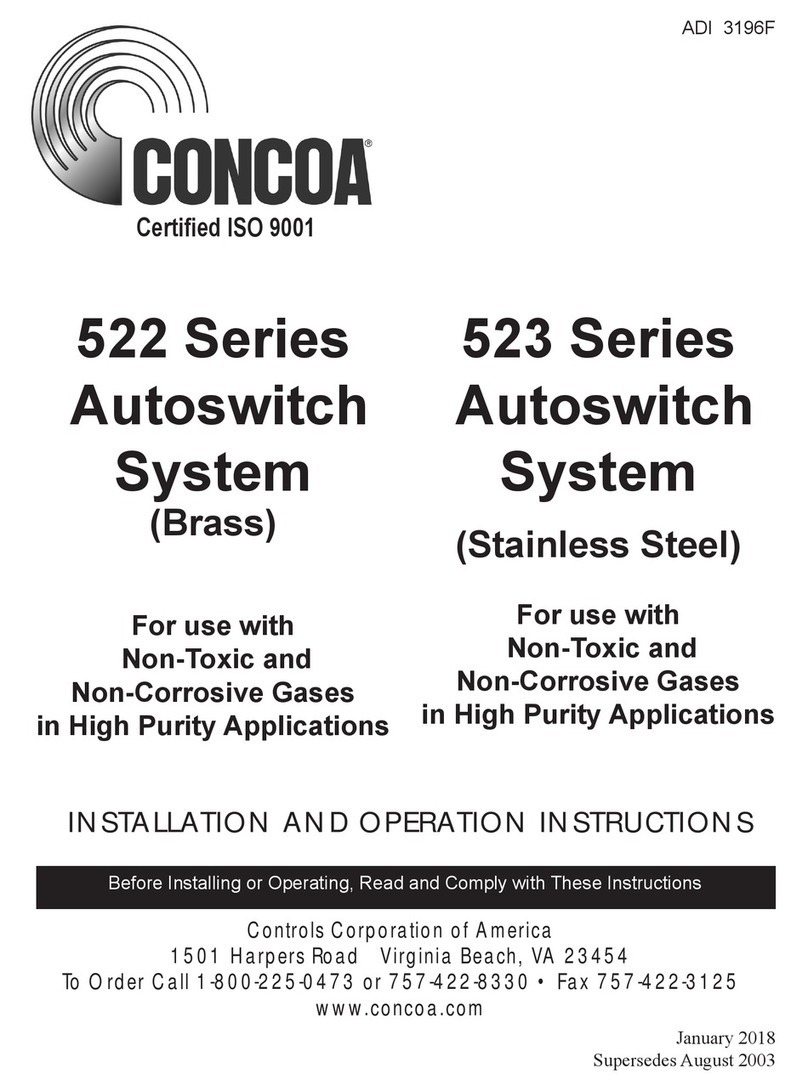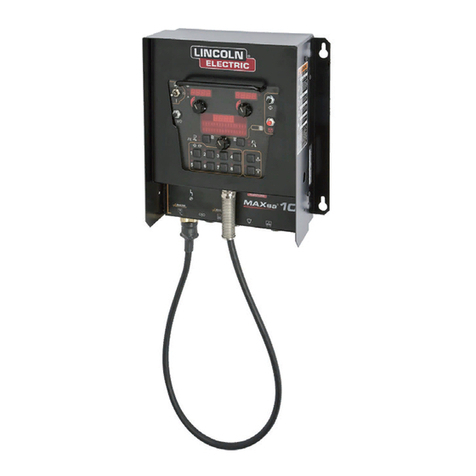WINDY NATION TrakMax 30L User manual

TrakMax 30L User Manual
Revision 1.0
windynation
TrakMax 30L
MPPT Solar Charge Controller
CHC-TRMX-30
User’s Manual
Page 1 of 29 windynation 05/06/2015

TrakMax 30L User Manual
Revision 1.0
Table of Contents
1Introduction ..................................................................................................................................................3
1.1 Safety ...................................................................................................................................................... 3
1.2 Definitions................................................................................................................................................3
2Product Overview.........................................................................................................................................4
2.1 Features .................................................................................................................................................. 4
2.2 Specifications .......................................................................................................................................... 5
2.2.1 Electrical Specifications.......................................................................................................................5
2.2.2 Physical Specifications........................................................................................................................ 6
2.2.3 Regulatory Information........................................................................................................................6
3Installation....................................................................................................................................................6
3.1 Electrostatic (ESD) Precautions..............................................................................................................7
3.2 Mounting..................................................................................................................................................7
3.3 Grounding................................................................................................................................................8
3.4 Connections.............................................................................................................................................8
3.5 Overcurrent Protection ..........................................................................................................................11
3.6 Overvoltage – Reverse Polarity Protection...........................................................................................11
3.7 Parallel Connection ...............................................................................................................................11
3.8 Temperature Sensors (Optional)...........................................................................................................11
3.8.1 Temperature Compensation..............................................................................................................12
3.8.2 Battery Temperature Sensor – BTS (BAT) .......................................................................................12
3.8.3 Environment Temperature Sensor (ENV) .........................................................................................13
3.9 Remote Monitor (Optional)....................................................................................................................14
3.9.1 Communication Cable.......................................................................................................................15
3.9.2 Connections.......................................................................................................................................15
3.9.3 Mounting............................................................................................................................................15
4Operation ...................................................................................................................................................16
4.1 Maximum Power Point Tracking (MPPT)..............................................................................................16
4.1.1 How MPPT Works.............................................................................................................................17
4.2 Power ....................................................................................................................................................17
4.3 LED Modes............................................................................................................................................17
4.4 Button Definitions ..................................................................................................................................18
4.5 LCD Graphic Indicators.........................................................................................................................18
4.6 LCD Interface Cycle ..............................................................................................................................19
4.7 Interface Definitions...............................................................................................................................19
4.7.1 PV / Solar Input Interface (Main)....................................................................................................... 19
4.7.2 Battery Interface – Charge Limit Setting ...........................................................................................19
4.7.3 Load Interface....................................................................................................................................20
4.7.4 Battery Capacity Interface.................................................................................................................20
4.7.5 Battery Temperature Compensation Interface..................................................................................20
4.7.6 Battery Type Interface....................................................................................................................... 21
4.8 Charge Mode.........................................................................................................................................22
4.8.1 Three Stage Charge..........................................................................................................................22
4.9 DC Load Control....................................................................................................................................22
4.9.1 Low Voltage Disconnect....................................................................................................................23
4.9.2 Low Voltage Reconnect ....................................................................................................................23
5Error Conditions.........................................................................................................................................23
6Troubleshooting and Support.....................................................................................................................24
6.1 Care.......................................................................................................................................................24
6.2 Troubleshooting.....................................................................................................................................24
6.3 Fuse Replacement ................................................................................................................................25
6.4 Support.................................................................................................................................................. 26
6.5 Limited Warranty ...................................................................................................................................26
6.6 Restrictions............................................................................................................................................26
6.7 Warranty Claims & Return Procedures.................................................................................................26
6.8 Disclaimer..............................................................................................................................................27
Page 2 of 29 windynation 05/06/2015

TrakMax 30L User Manual
Revision 1.0
6.9 Limitation of Liability..............................................................................................................................27
7Application..................................................................................................................................................28
7.1 Batteries ................................................................................................................................................ 28
7.1.1 Automotive Batteries .........................................................................................................................28
7.1.2 Maintenance-Free Batteries..............................................................................................................28
7.1.3 Deep-Cycle Batteries.........................................................................................................................28
7.1.4 Sealed Batteries................................................................................................................................28
7.1.5 Battery Sizing ....................................................................................................................................28
7.1.6 Equalization Charging .......................................................................................................................28
7.2 Wire Gauge Reference..........................................................................................................................29
1 INTRODUCTION
Thank you for purchasing the TrakMax 30L, another quality product from Windy Nation. This manual is intended
for anyone who needs to install and operate the solar charge controller.
The manual will provide safety guidelines, detailed planning, and procedures for installing and setting up the
solar charge controller, as well as information about operating and troubleshooting the unit.
The manual will not provide details about any of the connected equipment to the controller (eg: PV panels,
batteries, etc.). Information concerning any connected equipment should be available from the equipment
manufacturer.
1.1 SAFETY
Windy Nation Inc. (“Windy Nation”) is not assembling the wind unit, installing the solar system, or any other
product offered by Windy Nation. Windy Nation, and its directors, officers, and employees disclaim, and by
purchasing a Windy Nation wind or solar powered product you accept all liability and responsibility for damage
to property, injury, or death arising out of or related to the use or misuse of any product offered by Windy Nation.
Installation and servicing should be referred to qualified service personnel.
Remove all sources of power, photovoltaic and battery before servicing or installing.
During operation, the controller can be very hot to the touch.
Battery Safety
Warning: Batteries can produce explosive gasses; observe extreme caution.
Have plenty of fresh water and soap nearby in case battery acid contacts skin, clothing or eyes.
NEVER smoke or allow a spark or flame in the vicinity of the battery.
Be cautious of metal items such as jewelry and tools to reduce risk of short circuit.
Never charge a frozen battery.
Be sure battery is mounted in a well-ventilated compartment.
Purge excessive gas from the battery cells by filling each cell with distilled water until battery acid
reaches level specified by battery manufacturer. For batteries without cell caps, carefully follow
manufacturers charging instructions.
1.2 DEFINITIONS
•BTS Battery Temperature Sensor
•DC Direct Current
•LED Light Emitting Diode
•LVD Low Voltage Disconnect
•LVR Low Voltage Reconnect
Page 3 of 29 windynation 05/06/2015

TrakMax 30L User Manual
Revision 1.0
•B.SELECT Battery Type Selector
•BAT Battery
•CHG.MODE Charge Mode
•PV Photovoltaic
•MPPT Maximum Power Point Tracking
•PWM Pulse Width Modulation
2 PRODUCT OVERVIEW
The TrakMax solar charge controller is a 30 amp 12/24/48 Volt Maximum Power Point Tracking (MPPT)
photovoltaic (PV) battery charge controller. Through the use of MPPT technology, TrakMax can increase charge
current up to 30% or more compared to conventional solar charge controllers. TrakMax’s sophisticated three
stage charge control system can be configured to optimize charge parameters to precise battery requirements.
The unit is fully protected against voltage transients, over temperature, over current, reverse battery, and
reverse PV connections. An automatic current limit feature allows use of the full 30 amp capability without
worrying about overload or unnecessary fuse blows from excessive current, voltage, or amp-hour based load
control.
Series pass Pulse Width Modulation (PWM) charge voltage control combined with a multistage charge control
algorithm leads to superior charging and enhanced battery performance. The filtered PWM power control
system uses highly efficient and reliable power MOSFET transistors. The MOSFET’s are turned on and off at
high frequency to precisely control the charge voltage and the MPPT function.
Fully automatic temperature compensation of charge voltage is available to further improve charge control and
battery performance. The optional battery temperature sensor (purchased separately) is built for long term
reliability. The sensor element is environmentally sealed and encapsulated into a lug, which secures directly to
the battery. The TrakMax also includes an isolated RS485 port for connection to a remote monitor (purchased
separately).
For large system current applications (greater than 30 amps), multiple TrakMax units can be connected in
parallel.
2.1 FEATURES
Maximum efficiency of 97%
Wide PV Input Range (150V Voc)
DC Load Output Port (10A)
LCD and LED displays to indicate the status of charge
Lightning protection
Reverse current protection at night
Smart Error detection
Automatic overload protection
DSP controlled
Page 4 of 29 windynation 05/06/2015

TrakMax 30L User Manual
Revision 1.0
Natural Cooling
Silent, pulse width modulated (PWM), high efficiency operation
Dual Battery Temperature Compensation; (Optional Requires item CHC-BTSC-02)
Optional Remote Monitoring using (Requires item CHC-RMTR-01)
Configurable charging current (10A, 20A, 30A)
1
Fault LED
7
Battery Terminal
2
Charge LED
8
Temperature Sensor Connection*
3
PV LED
9
RS485 Remote Monitor Port*
4
Battery LED
10
PV Terminal Input
5
DC LOAD Terminal Output
11
Function Keys
6
Earth Ground Connection (unit side)
12
LCD Display
*Optional Equipment is required for operation (purchased separately)
2.2 SPECIFICATIONS
2.2.1 Electrical Specifications
Parameter
Value @25oC
Battery System Voltage
12 / 24 /48 VDC (auto-detect)
Page 5 of 29 windynation 05/06/2015

TrakMax 30L User Manual
Revision 1.0
Max Input Current
30 Amp
Max Battery Charging Current
10, 20, or 30 Amp
Load Current
10 Amp
Max PV Open Circuit Array Voltage
150VDC
Efficiency
97% @ full current
Typical Idle Consumption
< 160mA / 80mA / 40mA
Bulk Charge
14.4V(default)
Floating Charge
13.5V / 27V / 54V (default)
Over-voltage Indication
15.0 / 30.0 / 60.0 VDC
Over-voltage Recovery
14.8 / 29.6 / 59.2 VDC
Under-voltage Indication
8.5 / 17.0 / 34.0 VDC
Under-voltage Recovery
9.0 / 18.0 / 36.0 VDC
Temperature Compensation
0 - 10mV/oC (settable)
Load Control
ON / OFF
Low Voltage Reconnect
12.0 / 24.0 / 48.0 VDC
Low Voltage Disconnect
10.5 / 21.0 / 42.0 VDC
Altitude
Operating 6,560ft (2000m)
Enclosure Protection Class
IP20
Battery Temperature Sensor (BTS)
Optional sensor increases charging precision
Terminal Size (fine/single wire)
Maximum 6 AWG
NOTE: The optional battery temperature sensor automatically adjusts the charging process of the controller
according to the type of battery selected by the user. With the battery temperature sensor installed, the controller
will increase or decrease the battery charging voltage depending on the temperature of the battery to optimize the
charge to the battery and to maintain battery performance.
2.2.2 Physical Specifications
Parameter
Value
Dimension (H x W x D)
8.2” (210mm) x 6.7” (171mm) x 3.8” (98mm)
Unit Weight
4.4 lb. (2Kg)
Mounting
Vertical wall mount - indoor only
Cooling
Natural cooling
Operating Temperature
14oF to 122oF (-10oC to 50oC)
de-rating >104
o
F (40
o
C)
Storage Temperature
-25oC to 60oC
Operating Humidity
20 to 80% relative humidity (non-condensing)
Non-Operating Humidity
Greater than 95% relative humidity
38.7
o
C max wet bulb temperature with no damage
2.2.3 Regulatory Information
The TrakMax has safety approvals as follows:
•CE
•IEC 62109
FCC Requirements:
This device complies with Part 15 of the FCC rules. Operation is subject to the following two conditions: (1)
This device may not cause harmful interference, and (2) this device must accept any interference received,
including interference that may cause undesired operation.
3 INSTALLATION
Insure all terminating connections are clean and tight to prevent arcing and overheating.
Do not connect to a PV array capable of producing greater than 30 amps of short circuit current @ 25°C.
Do not connect to a PV array with an open circuit voltage (VOC) greater than 150VDC.
Page 6 of 29 windynation 05/06/2015

TrakMax 30L User Manual
Revision 1.0
Important: Installations should meet all local codes and standards. Installations of this equipment should only
be performed by skilled personnel such as licensed electricians and Certified Renewable Energy (RE) System
Installers.
Caution: Install the Solar charge controller in a dry, protected location away from sources of high temperature,
moisture, and vibration. Corrosion is not covered by the warranty.
3.1 ELECTROSTATIC (ESD) PRECAUTIONS
All electronic circuits may be damaged by static electricity. To minimize the likelihood of electrostatic damage,
discharge yourself by touching an electrical ground (e.g.: copper pipe) prior to handling the unit and avoid
touching components on the circuit boards. The risk of electrostatic damage is highest when relative humidity is
below 40%.
3.2 MOUNTING
The mounting location is important to the performance and operating life of the controller. The environment must
be dry and protected from water. If required, the controller may be installed in a ventilated enclosure with
sufficient airflow. Never install the TrakMax MPPT in a sealed enclosure. The controller may be mounted in an
enclosure with sealed batteries, but never with vented/flooded batteries. Battery fumes from vented batteries will
corrode and destroy the TrakMax MPPT circuits.
1) Place the TrakMax on a vertical surface protected from direct sun, high temperatures, and water. The
TrakMax requires at least 6 in (150 mm) of clearance above and below and at least 1 in (25 mm) on
each side for proper air flow as shown in figure below.
Page 7 of 29 windynation 05/06/2015

TrakMax 30L User Manual
Revision 1.0
2) Place the controller mounting bracket on the desired mounting surface and mark the location of each
keyhole (two per unit).
3) Secure the bracket using the two mounting screws (included).
a) If wall anchors (included) are to be used, a pilot hole will be required at the drill mark.
4) Remove the Mount-Lock screw on the TrakMax and carefully align the open ended keyholes on the
mounting bracket with the TrakMax Mounting screw heads and slide the TrakMax down into the
keyhole.
5) Replace the Mount-Lock screw on the TrakMax going first through the mounting bracket and into the
TrakMax and tighten for safety.
Warning: Explosion/Corrosion Hazard
Do not mount on flammable surface material (e.g.: wooden wall).
3.3 GROUNDING
The TrakMax is designed to work with grounded electrical systems. In the controller, ground is not connected to
the input terminal and output terminals.
Use a copper wire to connect the grounding terminal on the TrakMax enclosure to earth ground. The grounding
terminal is located on the left side of the enclosure as shown above.
Do not connect the system negative conductor to this terminal. NEC requires the use of an external ground fault
protection device (GFPD). The system electrical negative should be bonded through a GFPD to earth ground at
one (and only one) location. The grounding point may be located in the solar circuit or the battery circuit.
3.4 CONNECTIONS
WARNING: Shock Hazard
Solar PV array can produce open-circuit voltages in excess of 100 VDC when in sunlight. Verify that the solar
input breaker or disconnect has been opened (disconnected) before installing the system wires. Note that the
maximum PV open-circuit voltage for the TrakMax is 150 VDC. Do NOT attach the positive and negative PV
Page 8 of 29 windynation 05/06/2015

TrakMax 30L User Manual
Revision 1.0
cables to the TrakMax until the TrakMax has been connected to the positive and negative terminals of the
battery bank.
It is recommended to use a strain relief (bushings, connectors, clamp connectors, or wire glands) in each of the
three ¾ in openings.
The NEC requires that the wires carrying the system current never exceed 80% of the conductor’s current
rating. The table below provides the minimum size of copper wire allowed by NEC. Wire types rated for 75°C
and 90°C are included.
Wire Type
75°C Wire
90°C Wire
Copper
6 AWG (16 mm2)
8 AWG (10 mm2)
Aluminum
4 AWG (25 mm2)
6 AWG (16 mm2)
1) Remove the Wiring End Cover from the Top Cover by removing the four securing screws as shown below.
2) Route the relevant cable/wire through the appropriate ¾ in opening as noted on the cover.
Note: If strain reliefs (i.e.: cable clamps, wire glands) are being used, they must be installed prior to routing
the wire, and the wire should route through the clamp.
3) Terminal connectors for DC wiring are located on the lower edge of the circuit board. Once the
wires have been installed, tighten the terminals with the screw located on the top of the terminals to 1.2Nm
(10.6lb-in). Be careful not to over tighten.
Page 9 of 29 windynation 05/06/2015

TrakMax 30L User Manual
Revision 1.0
a) Load: Maximum 10A DC Load
•Connect a cable from the TrakMax terminal marked load negative (–) to the negative terminal of your
DC load and tighten the screw.
•Connect a cable from the TrakMax terminal marked load positive (+) to the positive terminal of your DC
load and tighten the screw.
b) Battery: 30A Rated Charge Current
•Connect a cable from the TrakMax terminal marked battery negative (–) to the negative (–) battery
terminal and tighten the screw.
•Connect a cable from the TrakMax terminal marked battery positive (+) on the Solar charge controller to
the positive (+) battery terminal and tighten the screw.
IMPORTANT: A properly sized fuse must be placed in the positive wire connecting the charge controller to
the battery.
c) PV: Photovoltaic System
•Connect the PV array’s positive (+) output to the terminal marked PV positive (+) on the TrakMax and
tighten the screw.
•Connect the PV array’s negative (–) output to the terminal marked PV negative (–) on the TrakMax and
tighten the screw.
IMPORTANT: A properly sized fuse must be placed in the positive wire connecting the solar panels to the
charge controller.
4) Double Check All Connections to ensure they are secure.
5) Replace the Wiring Cover removed in step 1 and secure with the four screws.
6) Tighten the cable clamps (if applicable)
Insert Wire/Cable Here
Tighten Terminals Here
Page 10 of 29 windynation 05/06/2015

TrakMax 30L User Manual
Revision 1.0
CAUTION: Risk of Fire and Shock
Connect battery terminals prior to the connection of array terminals.
3.5 OVERCURRENT PROTECTION
Circuit breakers or fuses must be installed in both the battery and solar circuits. The protection device ratings
and installation methods must conform to NEC requirements.
The battery circuit fuses or circuit breaker must be rated to 125% of the maximum current or more. The
minimum fuse/breaker rating allowed for use with each TrakMax is 1.25 x 30 Amps = 37 Amps.
If the TrakMax controller system detects an overload status, it will automatically reset the over current protection
system every 6 minutes. If the fault is still present, the controller will shut off and wait for another 6 minutes. This
will occur continuously until the problem is corrected.
A disconnect is required for the battery and solar circuits to provide a means for removing power from the
TrakMax. Double pole switches or breakers are convenient for disconnecting both solar and battery conductors
simultaneously.
3.6 OVERVOLTAGE –REVERSE POLARITY PROTECTION
The TrakMax is fully protected against reverse polarity and high voltage transients for both the PV and the
battery connections. If the battery is connected in the reverse polarity position, the TrakMax inner fuse will open.
If the PV array is connected in the reverse polarity position, the TrakMax will not turn on.
3.7 PARALLEL CONNECTION
Multiple TrakMax controllers can be installed in parallel on the same battery bank to achieve higher charging
current. For example, connecting two TrakMax units in parallel can allow for 60 amps of charging current, and
connecting three TrakMax units in parallel can allow for up to 90 amps of charging current. Additional parallel
controllers can also be added in the future. Each TrakMax MPPT Controller must have its own PV array. See
figure below
3.8 TEMPERATURE SENSORS (OPTIONAL)
The charge voltage required by batteries changes with battery temperature. Temperature compensation of the
charge voltage enhances battery performance and life, and decreases battery maintenance.
The TrakMax has dual temperature sensors to detect environmental changes to the battery location as well as
detecting excessive battery temperatures that can be harmful to the battery.
Page 11 of 29 windynation 05/06/2015

TrakMax 30L User Manual
Revision 1.0
Automatic temperature compensation can be provided through use of the optional Temperature Sensor Kit (Part
#: CHC-BTSC-02) that includes two temperature sensor cables and the required connector to interface with the
TrakMax. Please contact your Windy Nation supplier for availability.
3.8.1 Temperature Compensation
Temperature compensation is based on battery type-5mv/cell for lead acid type batteries and 2mv/cell for
alkaline type batteries (NiCad or NiFe). The temperature compensation calculations are derived from the
following table:
Battery Type
12 Volt Units
24 Volt Units
48 Volt Units
Lead Acid
0.03 volts (30mv) per
degree Celsius
0.06 volts (60mv) per
degree Celsius
0.12 volts (120mv) per
degree Celsius
NiCad
0.02 volts (20mv) per
degree Celsius
0.04 volts (40mv) per
degree Celsius
0.08 volts (80mv) per
degree Celsius
The table below describes approximately how much the voltage may vary depending on the temperature of the
batteries:
Temperature
12 Volt Units
24 Volt Units
48 Volt Units
Celsius
Fahrenheit
Lead Acid
(6 cells)
Lead Acid
(12 cells)
Lead Acid
(12 cells)
NiCad
(20 cells)
Lead Acid
(24 cells)
NiCad
(40 cells)
60
140
-1.05
-2.1
-2.1
-1.4
-4.2
-2.8
55
131
-0.90
-1.8
-1.8
-1.2
-3.6
-2.4
50
122
-0.75
-1.5
-1.5
-1.0
-3.0
-2.0
45
113
-0.60
-1.2
-1.2
-0.8
-2.4
-1.6
40
104
-0.45
-0.9
-0.9
-0.6
-1.8
-1.2
35
95
-0.30
-0.6
-0.6
-0.4
-1.2
-0.8
30
86
-0.15
-0.3
-0.3
-0.2
-0.6
-0.4
25
77
0
0
0
0
0
0
20
68
0.15
0.3
0.3
0.2
0.4
0.4
15
59
0.30
0.6
0.6
0.4
0.8
0.8
10
50
0.45
0.9
0.9
0.6
1.8
1.2
5
41
0.60
1.2
1.2
0.8
2.4
1.6
0
32
0.75
1.5
1.5
1.0
3.0
2.0
-5
23
0.90
1.8
1.8
1.2
3.6
2.4
-10
14
1.05
2.1
2.1
1.4
4.2
2.8
-15
5
1.20
2.4
2.4
1.6
4.8
3.2
-20
-4
1.35
2.7
2.7
1.8
5.4
3.6
-25
-13
1.50
3.0
3.0
2.0
6.0
4.0
-30
-22
1.65
3.3
3.3
2.2
6.6
4.4
-35
-31
1.80
3.6
3.6
2.4
7.2
4.8
-40
-40
1.95
3.9
3.9
2.6
7.8
5.2
Variances in charging voltage based on battery temperature
3.8.2 Battery Temperature Sensor – BTS (BAT)
The Battery Temperature Sensor will sense battery temperature and will adjust charging to protect the
battery from permanent damage.
When the BTS detects a temperature of 40oC (104oF) the TrakMax will reduce the charge current by 50% to
reduce heat dissipation.
Page 12 of 29 windynation 05/06/2015

TrakMax 30L User Manual
Revision 1.0
When the BTS detects a temperature of 50oC (122oF) the TrakMax will stop the charge current until the
temperature is within a safe operating zone.
3.8.2.1 BTS Installation
1) The BTS cable is 5m in length and has two plain wires on one end and lug on the other end.
2) Strip approximately ¼” from each wire end, insert the bare wire into the two left terminals on the
temperature sensor connector, and tighten the terminal screws on top of the connector as shown below.
3) Plug the provided Temperature Sensor Connector into the socket located on the controller labeled
“Temp Sensor” and tighten the two captive screws to secure the connector in place as shown below.
4) Secure the BTS on the side of the battery below the electrolyte level as shown below. It is best to place
the sensor between batteries and place the batteries in an insulated box to reduce the influence of the
ambient temperature outside the battery enclosure.
3.8.3 Environment Temperature Sensor (ENV)
The Environment Sensor is used to automatically compensate the charging voltage based on the Battery
Temperature Compensation setting; See Sec 4.7.5.
3.8.3.1 ENV Installation
1) The ENV cable is 5M in length and has two plain wires on one end and a thermocouple sensor on the
other end.
2) Strip approx. ¼” from each wire end, insert the bare wire into the two right terminals on the temperature
sensor connector, and tighten the terminal screws on top of the connector as shown below.
3) Plug the provided Temperature Sensor Connector into the socket located on the controller labeled
“Temp Sensor” and tighten the two captive screws to secure the connector in place as shown below.
Page 13 of 29 windynation 05/06/2015

TrakMax 30L User Manual
Revision 1.0
4) Place the sensor close to the batteries but not in direct contact with the batteries.
CAUTION: High power electrical systems pose dangers and it is the user's responsibility to be familiar with
these dangers and take any necessary action to ensure safe use. Shorting a battery or connecting your
controller to a battery can supply huge currents and have serious consequences including explosions, causing
fire, damage to equipment, and personal injury.
3.9 REMOTE MONITOR (OPTIONAL)
Windy Nation offers an optional remote monitor (CHC-RMTR-01) that allows the user to monitor and configure
the system from the remote LCD interface as opposed to the LCD interface located on the TrakMax. The
Remote Monitor comes with a 5m cable and mounting bracket.
Parameter
Value
Dimension (H x W x D)
3.62” (92mm) x 4.33” (110mm) x 1.30” (33mm)
Unit Weight
7.2 oz. (204g)
Mounting
Vertical wall mount - indoor only
Enclosure Protection Class
IP20
Operating Temperature
14oF to 140oF (-10oC to 60oC)
Power Supply
5VDC – 200mA
Communication Type
RS-485
Communication Range
1000M
Page 14 of 29 windynation 05/06/2015

TrakMax 30L User Manual
Revision 1.0
3.9.1 Communication Cable
The remote monitor uses RS485 communication via a standard 8-wire RJ45 telephone cable (straight-through,
not a Null Modem / cross-over). If possible, pull the cable through conduit before crimping on the RJ45
connectors. If using pre-assembled cables, take care not to damage the plugs when the cables are pulled
through conduit.
WARNING: Shock Hazard
Never route network cables in the same conduit as the power conductors.
3.9.2 Connections
The RJ45/RS485 communication port on the controller will provide power to the Remote Monitor for lengths of
5M or less. For distances greater than 5m, the Remote Monitor will require an auxiliary 5VDC power input.
IMPORTANT: Cable length cannot exceed 1 kilometer.
IMPORTANT: If the Remote Monitor shows error “102”, please check the cable connection.
3.9.3 Mounting
There are two ways of mounting the Remote Monitor.
1. Key Holes: The Remote Monitor has two keyholes located on the rear of the enclosure
a. Secure two screws onto the mounting surface 2.58” (65mm) apart.
b. Align the keyholes with the head of the screws.
Page 15 of 29 windynation 05/06/2015

TrakMax 30L User Manual
Revision 1.0
c. Slide the Monitor down until the monitor is secure in place.
2. Mounting Bracket (included)
a. Secure the mounting bracket in desired location using two or three screws.
b. Align the bracket locks on the bracket with the bracket locks on the rear of the monitor.
c. Slide the monitor down until a click is heard and the monitor is secured in place.
4 OPERATION
4.1 MAXIMUM POWER POINT TRACKING (MPPT)
Maximum Power Point Tracking, frequently referred to as MPPT, is an electronic system that operates the
Photovoltaic (PV) modules in a manner that allows the PV modules to produce all the power they are capable of
producing.
MPPT and associated current boost operation is fully automatic and will function whenever sufficient PV voltage
and current are available. The percent increase in output charge current relative to PV current is variable, and
will change with operating conditions. When conditions are such that insufficient PV power is available to
produce an increase in output current, the unit will stop its internal DC-DC power conversion and operate as a
series pass PWM controller with very low forward voltage drop.
The principal operating conditions which affect current boost performance are PV array temperature and battery
voltage. At constant solar intensity, available PV power changes with PV temperature. A PV array’s power vs.
temperature characteristic is such that a cool PV array can produce a higher voltage and more power, than a
hot PV array. When PV voltage is sufficiently high for MPPT to operate, a constant power output is delivered to
the battery. Since output power is constant while MPPT is operating, a decrease in battery voltage produces
corresponding increase in charge current. This means that the greatest current increase occurs with a
combination of cool ambient temperature and low battery voltage. The unit delivers the greatest charge current
increase when you need it most, in cold weather with a discharged battery. Additionally, anything that can be
done to lower PV array temperature will also lead to increased charge current by increasing PV power
production. In cool/comfortable temperatures and typical battery states of charge, most systems see about 10 –
20% increase. Charge current increase can go to zero in hot temperatures, whereas charge current increase
can easily exceed 30% with a discharged battery and freezing temperatures.
Page 16 of 29 windynation 05/06/2015

TrakMax 30L User Manual
Revision 1.0
Current / Power vs. Voltage Characteristics
4.1.1 How MPPT Works
A PV module is a constant current type device. As shown on a typical PV module voltage vs. current curve,
current remains relatively constant over a wide range of voltage. A typical 75 watt module is specified to deliver
4.45 amps @ 17 volts @ 25 C cell temperature. Conventional PV controllers essentially connect the PV array
directly to the battery when the battery is discharged. When a 75 watt PV module is connected directly to a
battery charging at 12 volts, the PV module still provides approximately the same current. But because output
voltage is now at 12 volts rather than 17 volts, the PV module’s power production is artificially limited and the
75W PV module only delivers 53 watts. This wastes 22 watts of available power.
TrakMax’s MPPT technology operates in a very different fashion. Under these conditions TrakMax calculates
the maximum power voltage (V) at which the PV module delivers maximum power, in this case 17 volts. It then
operates the PV module at 17 volts which extracts maximum available power from the PV module. TrakMax
continually recalculates the maximum power voltage as operating conditions change. Input power from the
maximum power tracking controller, in this case 75 watts, feeds a switching type power converter which reduces
the 17 volt input to battery voltage at the output. The full 75 watts which is now being delivered at 12 volts would
produce a current of 6.25 amps. A charge current increase of 1.8 amps or 40% is achieved by converting the 22
watts that would have been wasted into useable charge current. Note that this example assumes 100%
efficiency to illustrate the principal of operation. In actual operation, the power boost will be somewhat less.
4.2 POWER
Once the controller is properly connected to a battery, the solar controller will start automatically. The main
display interface will appear in the LCD and the current PV / Solar panel voltage and current will be displayed.
Press the ‘UP’ or ‘DOWN’ buttons to cycle through the six different interfaces available on the TrakMax
controller. The cycle pattern of the interfaces is presented in Section 4.5 and some of the parameters are user
configurable. When any key is pressed, the LCD backlight will automatically turn on. The backlight will
automatically turn off when the controller is idle for 30 seconds.
To power down the controller, cover the solar panels and disconnect the PV input to the controller. Remove the
battery connection and check the charge controller status. Once the LEDs and LCD display turn off, the charge
controller is shut off.
4.3 LED MODES
The TrakMax has four LED indicators to quickly observe the operating status of the controller.
Page 17 of 29 windynation 05/06/2015

TrakMax 30L User Manual
Revision 1.0
LED
ON
OFF
PV
PV input voltage present No input PV voltage
BAT
BATTERY voltage present
No BATTERY voltage
CHARGE
CHARGING in process
No CHARGING
FAULT
FAULT or abnormality present Normal Operation
4.4 BUTTON DEFINITIONS
Button
Name
Description
ENTER Enter into current parameter setting state. Once in provisioning
mode, the parameter will blink. Once finished, press ENTER
again to save parameter settings.
UP Cycle interface settings to next available interface.
Positive (+) parameter adjustments to modify parameter values.
DOWN Cycle interface settings to previous available interface.
Negative (-) parameter adjustments to modify parameter values.
BACK Escape interface setting without saving the current parameters
and return to MAIN page
4.5 LCD GRAPHIC INDICATORS
LCD Symbol
Description
PV – Solar Panel Array Symbol.
BATTERY Symbol.
Each cell corresponds to 20% of the battery capacity.
Capacity is calculated based on 100% of full voltage.
LOAD Symbol
Page 18 of 29 windynation 05/06/2015

TrakMax 30L User Manual
Revision 1.0
ERROR Symbol.
When present check the TrakMax controller and refer to Section
5 (Error Conditions) and 6 (Troubleshooting)
PARAMETER SET Symbol
When present in a particular interface, there is a user
configurable parameter available. Press ENTER and the
4.6 LCD INTERFACE CYCLE
4.7 INTERFACE DEFINITIONS
The TrakMax has six different graphical interfaces. Each interface contains different information. There are five
interfaces with the symbol , these interfaces contain configurable parameters.
4.7.1 PV / Solar Input Interface (Main)
This is the MAIN Interface and the displayed number is the present Solar Panel voltage (displayed in Volts) and
the solar panel current (displayed in Amps).
4.7.2 Battery Interface – Charge Limit Setting
The Battery Interface displays the current Battery voltage and current. The TrakMax supports a maximum
charging current of 30A, but this can be modified to limit the charge to 10A, 20A, or 30A. Default Setting: 30A.
From the Battery Interface, press the ENTER key and hold for 3 seconds to enter setup mode. Once in setup
mode will blink and “LIMIT” will be displayed. Press the UP or DOWN keys to adjust to the desired value and
press ENTER to save and return to main page.
NOTE: If you do not want to save the setting, press the BACK key to return to main page and original set value.
Solar Panel Voltage
PV Indicator
Solar Panel Current
Page 19 of 29 windynation 05/06/2015

TrakMax 30L User Manual
Revision 1.0
4.7.3 Load Interface
The value displayed in this interface is the output voltage and current from the controller to the load; i.e.: the
current being consumed by the load (displayed in Amps).
From the Load Interface, press the ENTER key and hold for 3 seconds to enter setup mode. Once in setup
mode will blink and “TYPE” will be displayed. Press the UP or DOWN keys to adjust the DC Load to be “ON”
or “OFF”. Once correct, press ENTER to save and return to main page.
NOTE: If you do not want to save the setting, press the BACK key to return to main page and original set value.
4.7.4 Battery Capacity Interface
The Battery Capacity Interface displays the battery capacity as set by the user and the temperature at the
Battery Temperature Sensor (BTS) as described in Section 3.8 (displayed in degrees Celsius). The temperature
is used for the temperature compensation of battery charging. The battery capacity can be modified to
accurately depict the end user system.
Default Setting: 200Ah.
To set the Battery Capacity, press the ENTER key and hold for 3 seconds to enter setup mode. Once in setup
mode will blink. Press the UP or DOWN keys to adjust to the desired value and press ENTER to save and
return to main page. Valid Range: 1 to 999Ah.
NOTE: If you do not want to save the setting, press the BACK key to return to main page and original set value.
4.7.5 Battery Temperature Compensation Interface
The values displayed in the Battery Temp Compensation interface is the current battery’s state of charge and
the current temperature compensation setting as described in Section 3.8.1 (displayed as millivolts per degree
Celsius).
Default Setting: 4mV/oC
Note: Set to 0 mV/oC when the Temperature Sensors are not used.
Load Status
Load Indicator
BAT Indicator
Battery Voltage
Battery Current
Current Charging Limit
Load Voltage
Load Current
Battery Capacity
BTS Temperature
Page 20 of 29 windynation 05/06/2015
This manual suits for next models
1
Table of contents
Other WINDY NATION Controllers manuals
Popular Controllers manuals by other brands
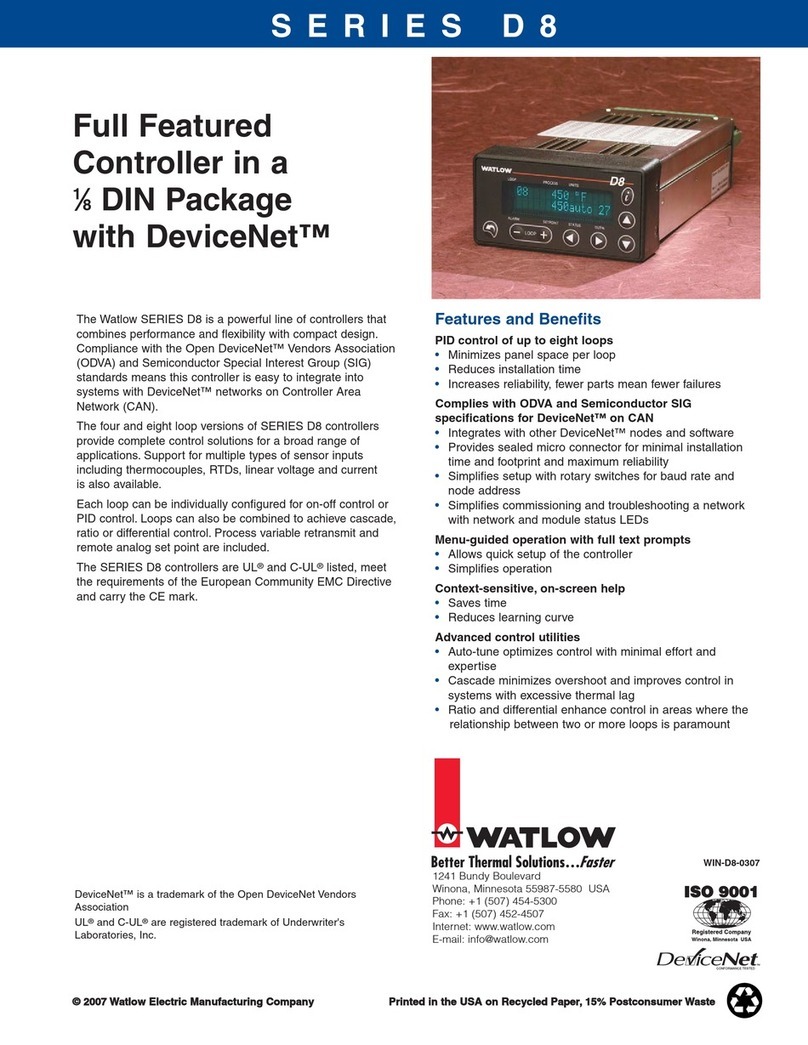
Watlow
Watlow Controller Series D8 Specifications
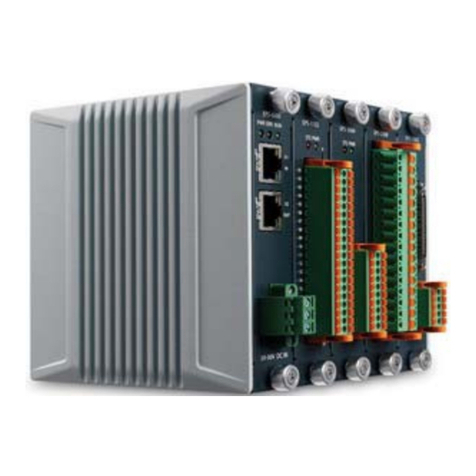
ADLINK Technology
ADLINK Technology EPS Series user manual
ON Semiconductor
ON Semiconductor NCP1201 manual
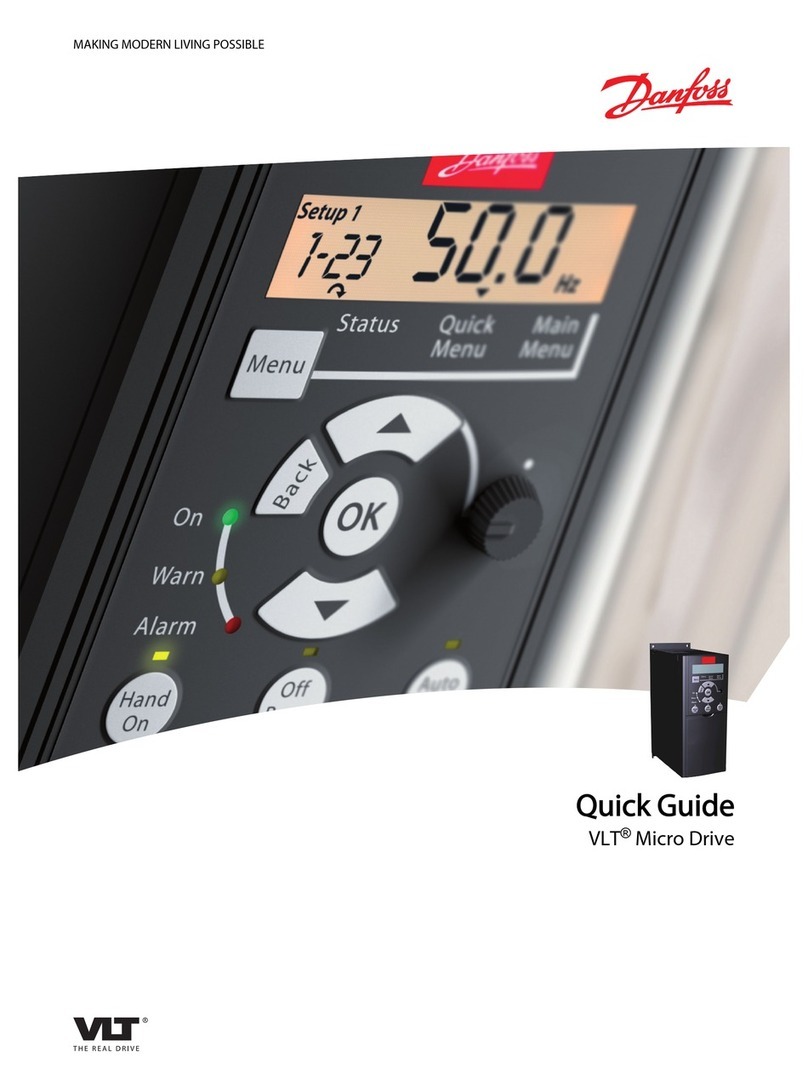
Danfoss
Danfoss VLT Micro Drive FC 51 Series quick guide
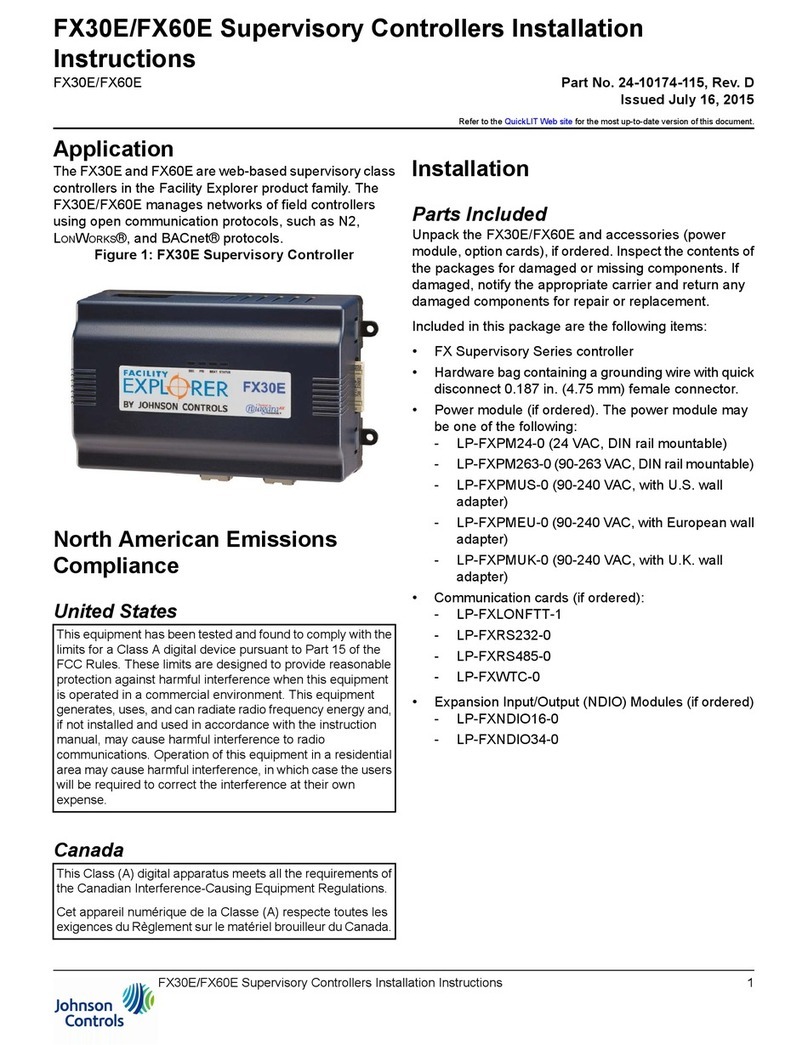
Johnson Controls
Johnson Controls FX30E Installation instructions manual
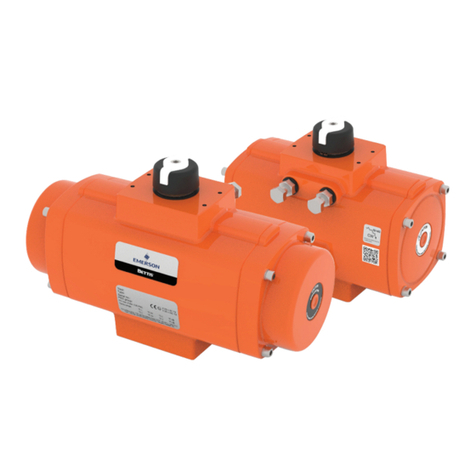
Emerson
Emerson Bettis RPE Series Installation, operation and maintenance manual
